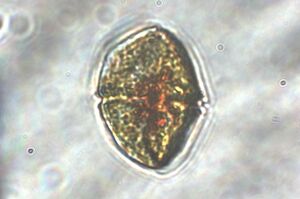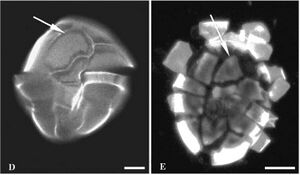Kryptoperidinium foliaceum
Classification
Domain: Eukaryota
Phylum: Dinoflagellata
Class: Dinophyceae
Order: Peridiniales
Family: Peridiniaceae
Genus: Kryptoperidinium
Species
|
NCBI: K. foliaceum Taxonomy [1] |
Kryptoperidinium foliaceum
Description and Significance
The external appearance of this microbe is a round, imperfect circular shape. In color, it appears to be a golden brownish. On the surface, there are many smaller circles, and important to note, there is an eyespot almost exactly in the center. [12] The habitat of this species is typically marine environments, more specifically, areas with a hypersalinic environment, as Kryptoperidinium foliaceum thrives under hypersalinic conditions, although sometimes it can be found in coastal areas and estuaries as well. In fact, Kryptoperidinium foliaceum was first discovered in a hypersaline environment in Kuwait. There was a direct correlation between the saline concentration and the Kryptoperidinium foliaceum population, the higher the saline concentration, the higher the population. [1] This is significant due to huge impact it has on the ecosystem with blooms and fish dying and other negative effects.
Genome Structure
K. foliaceum's DNA is circular and double stranded.
The size of the K. foliaceum genome is 0.3 mega base pairs.
The GC content is 55.4%. [9]
Cell Structure, Metabolism and Life Cycle
Interesting facts regarding the cell structure of K. foliaceum include that it is a binucleate dinoflagellate, and that the endosymbiont nucleus is a diatom. Another interesting fact to be noted is that the endosymbiont is a tertiary endosymbiont, meaning a secondary plastid that contains an algae has been engulfed by a heterotrophic eukaryote. [4] K. foliaceum, like many other dinoflagellates, gains energy through photosynthesis. [11] Typically dinoflagellates produce toxins that cause blooms, however K. foliaceum doesn't. In fact the only molecule produced by K. foliaceum is an odor that is known to kill fish. When it comes to the life cycle of K. foliaceum, it is a complex topic with many discoveries still waiting to be made. However to summarize the findings so far, some of the important points to note are about the vegatative state which begins during the germination of a cyst, the asexual reproductive cycle which has two forms, both a motile and non-motile state, the sexual reproductive cycle which yields either a single dinokaryon, endosymbiont nucleus, and cell, or multiple dinokaryons, endosymbiont nuclei, and cells, up to four to be exact. An important point to note is that only the host nucleus undergoes mitosis, but the endosymbiont nucleus undergoes neither mitosis or meiosis, however there being an S phase suggests further research needs to be done in that area. An interesting fact is that K. foliaceum is the intermediate stage of endosymbiont reduction. [4]
Ecology and Pathogenesis
Kryptoperidinium foliaceum can be found in various regions around the world, including the Mediterranean Sea, the Gulf of Mexico, and the Atlantic and Pacific coasts of North America. It is a common inhabitant of coastal waters, such as shallow water lagoons, estuaries and tidal creeks. K. foliaceum tends to thrive in environments with high salinity levels, but can tolerate an extensive range of salinities, from fresh and brackish waters up to waters with hypersalinity. The density of the Kryptoperidinium foliaceum population and distribution in many areas has been strongly correlated with a salinity pattern, as higher salinities tend to have a higher population of K. foliaceum. [1]
High salinities have also been correlated with Kryptoperidinium foliaceum blooms. These algal blooms are harmful to the fish, invertebrates, and other marine organisms in the regions where they occur. While many dinoflagellate blooms produce toxins, K. foliaceum blooms do not produce these toxins, and instead cause noxious odors as well as kill fish and other organisms by depleting the water of its dissolved oxygen. [5]
References
[1] Al-Yamani, F., Saburova, M., & Polikarpov, I. (2012, January 1). A preliminary assessment of harmful algal blooms in Kuwait’s marine environment. Aquatic Ecosystem Health & Management, 15(1), 64-72.
[2] Bercovici, A., & Vellekoop, J. (2017). Methods in Paleopalynology and Palynostratigraphy: An Application to the K-Pg Boundary. In K. E. Zeigler & W. Parker (Eds.), Terrestrial Depositional Systems: Deciphering Complexities Through Multiple Stratigraphic Methods (pp. 127-164). Elsevier Science.
[3] Culture Collection of Algae and Protozoa. (n.d.). Kryptoperidinium foliaceum. Culture Collection of Algae and Protozoa.
[4] Figueroa, R. I., Bravo, I., Fraga, S., Garces, E., & Llaveria, G. (2009, May). The Life History and Cell Cycle of Kryptoperidinium foliaceum, A Dinoflagellate with Two Eukaryotic Nuclei. Protist, 160(2), 285-300.
[5] Gagat, P., Bodył, A., Mackiewicz, P., & Stiller, J. W. (2013). Tertiary Plastid Endosymbioses in Dinoflagellates. In W. Löffelhardt (Ed.), Endosymbiosis (p. 263). Springer Vienna.
[6] Imanian, B., Pombert, J.-F., & Keeling, P. J. (2010, May 19). The Complete Plastid Genomes of the Two ‘Dinotoms’ Durinskia baltica and Kryptoperidinium foliaceum. PLoS One, 5(5).
[7] Kempton, J. W., Wolny, J., Tengs, T., Rizzo, P., Morris, R., Tunnell, J., Scott, P., Steidinger, K., Hymel, S. N., & Lewitus, A. J. (2002, September 28). Kryptoperidinium foliaceum blooms in South Carolina: a multi-analytical approach to identification. Harmful Algae, 1(1), 387.
[8] WoRMS & Guiry, M. D. (2016, June 26). Kryptoperidinium foliaceum (F.Stein) Lindemann, 1924. World Register of Marine Species.
[9] F, B. (n.d.). Species. diArk.
[10] Imanian, B., Pombert, J.-F., & Keeling, P. J. (2010, May 19). The complete plastid genomes of the two “dinotoms” Durinskia Baltica and Kryptoperidinium foliaceum. PloS one.
[11] Leblond, J., & Vandergrift, S. (2021, November 23). Sterols of the ‘dinotom’ Durinskia baltica (Dinophyceae) are of dinoflagellate origin. Wiley Online Library | Scientific Research Articles, journals, books, and reference works.
[12] Ross F. Waller, AbstractDinoflagellates are exemplars of plastid complexity and evolutionary possibility. Their ordinary plastids are extraordinary, Agrawal, S., Bodył, A., Dang, Y., Daugbjerg, N., Eriksen, N. T., Figueroa, R. I., Gómez, F., Gornik, S. G., Koumandou, V. L., Matsumoto, T., Nash, E., Nelson, M. J., Nisbet, R. E. R., Norén, F., Oborník, M., Onuma, R., Patron, N. J., … Gavelis, G. S. (2017, July 29). Plastid complexity in dinoflagellates: A picture of gains, losses, replacements and revisions. Advances in Botanical Research.
Author
Page authored by Harini Sunder and Hunter Trier, students of Prof. Jay Lennon at Indiana University.



